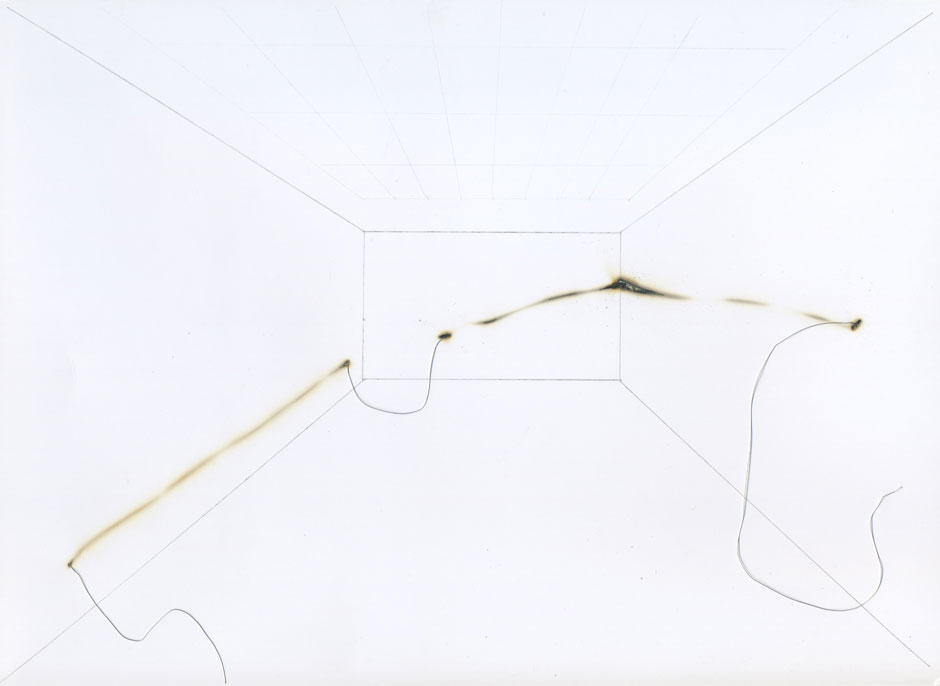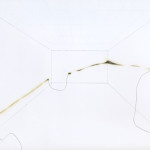Exhibition
in Glarus / Switzerland
- Judith Fegerl: cauter, 2015, Skizze
- Sophie Bueno-Boutellier: Perceptible, 2015
In an age where all channels are broadcasting non-stop around the clock, the programming pause has become the exception. Gaps between channels, where sounds of static once marked the transition between shows or the end of the broadcasting day, are only rarely heard in the digital world. In today’s world of input and image overload, monotonous noise has even become a concept for serenity, silence, and emptiness. Downloadable white noise tracks promise better sleep, greater stress relief, and optimized concentration. In open space offices pink noise regulates disparate sounds, creating an atmosphere that is simultaneously serene and stimulating. Other colored noise tonalities, such as blue, green, gray, brown, and red noise, are audio concepts that are seen as having a comparable spectrum of varying qualities and influences on mental and visual perception in their referencing of colored light. Noise is characterized here as a chaotic superimposition of all frequencies into a neutral and primarily monotone ambient soundscape. Noise is generated in all frequency ranges, not just in the realm of sound, but also in light. It is a concept for both nothingness and an overwhelming everything – complete emptiness and absolute fullness at the same time.
In the history of art, the theme of the void, presented, for example, as a white canvas or as a piece of music absent of sound, has a long tradition. Countless concepts of religion, philosophy, mathematics, and the natural sciences have also sprung up around notions of the void and nothingness. In the process, absolute nothingness, the void, has remained a theoretical phenomenon. Most people equate the void with a lack of identifiable structures. To some extent, the void is created in the eye of the observer and in the ear of the listener. Here, where only a few places remain for the mind to affix to, the imagination fills up the vacuum.
This exhibition brings together artists who are interested in the invisible, the latent, and what cannot be depicted. Employing a wide range of means and approaches they reference the phenomenon of white noise. For them, this is partly about reduction and partly about doing away with the limits of form and content. They experiment with sound and color as well as soundlessness and non-color and they and incorporate electrical, acoustic, and imaginary energies. In multiple works, architecture and the exhibition space, the White Cube, play important roles as a neutral, ideal setting for the presentation of art as well as a space for reflection and feedback, or they address the mechanisms of control and the creative repurposing thereof in an age of omnipresent background noise and image overload.
Kunsthaus Glarus would like to thank: Minerva Kunststiftung, Kanton Basel-Stadt Kultur, Österreichisches Kulturforum Bern, Lotteriefonds Kanton Glarus, Migros Kulturprozent, Pro Helvetia – Schweizer Kulturstiftung
Opening hours Tues-Fri 2 – 6 pm, Sat/Sun 11 am – 5 pm
In einer Zeit, in der rund um die Uhr auf allen Kanälen gesendet wird, ist die Sendepause zur Ausnahme geworden. Die Zwischenräume zwischen den Sendekanälen, wo das Rauschen einst den Übergang zwischen Sendern oder das Ende des Sendetages markierte, ist in der digitalen Welt nur noch selten hörbar. Im heutigen reiz- und bildüberfluteten Alltag ist die monotone Geräuschkulisse gar zu einem Konzept für Ruhe, Stille und Leere geworden. Downloadbare White Noise tracks versprechen einen besseren Schlaf, effizientere Stressreduktion und optimierte Fokussierung. In Grossraumbüros reguliert Pink Noise die Lärmanteile zu einer ruhigen und gleichzeitig anregenden Atmosphäre. Auch andere Farbtonalitäten von Geräuschen, etwa Blue, Green, Grey, Brown und Red Noise sind Audiokonzepte, deren Referenz zu farbigem Licht ein vergleichbares Spektrum unterschiedlicher Qualitäten und Einflüsse auf das mentale und visuelle Empfinden zugeschrieben wird. Das Rauschen wird dabei charakterisiert als eine chaotische Überlagerung aller Frequenzen zu einer neutralen, monotonen Geräuschkulisse. Rauschen entsteht in allen Frequenzbereichen, nicht nur im Bereich des Tons, sondern auch demjenigen des Lichts. Es ist sowohl ein Konzept für das Nichts als auch eines für ein überwältigendes Alles – komplette Leere und absolute Fülle zugleich.
In der Geschichte der Kunst hat die Beschäftigung mit der Leere, etwa inszeniert als weisse Bildfläche oder lautloses Musikstück, eine lange Tradition. Um die Leere und das Nichts ranken sich auch unzählige Konzepte der Religion, Philosophie, Mathematik und der Naturwissenschaft. Absolute Leere, das Nichts, ist dabei ein theoretisches Phänomen geblieben. Für die meisten Menschen ist das Nichts gleichbedeutend mit der Abwesenheit von identifizierbaren Strukturen. Das Nichts entsteht gewissermassen im Auge des Betrachters und im Ohr des Hörers. Dort, wo die eigene Wahrnehmung nur noch wenige Haltepunkte besitzt, füllt die Imagination das Vakuum.
Die Ausstellung bringt Künstlerinnen und Künstler zusammen, die sich für das Unsichtbare, Latente und das Nichtdarstellbare interessieren. Mit ganz unterschiedlichen Mitteln und Ansätzen beziehen sie sich dabei auf das Phänomen des weissen Rauschens. Ihnen geht es teils um Reduktion und teils um Entgrenzung von Form und Inhalt. Sie arbeiten sowohl mit Sound und Farbe als auch mit Lautlosigkeit und Nicht-Farbe oder beziehen akustische, elektrische wie auch imaginäre Energien in ihre Experimente mit ein. In mehreren Arbeiten spielen die Architektur und der Ausstellungsraum, der White Cube, als neutrale Ideal-situation für die Präsentation von Kunst aber auch als Resonanz- und Wahrnehmungsraum eine bedeutende Rolle oder sie beschäftigen sich mit den Kontrollmechanismen sowie deren kreativer Umnutzung in Zeiten allgegenwärtiger Geräuschkulissen und Bilderfluten.
Das Kunsthaus Glarus dankt: Minerva Kunststiftung, Kanton Basel-Stadt Kultur, Österreichisches Kulturforum Bern, Saly Frommer Foundation, Lotteriefonds Kanton Glarus, Migros Kulturprozent, Pro Helvetia – Schweizer Kulturstiftung
Öffnungszeiten Di-Fr 14 – 18 Uhr, Sa/So 11 – 17 Uhr
Location:
Kunsthaus Glarus
Im Volksgarten
8750 Glarus
Switzerland



